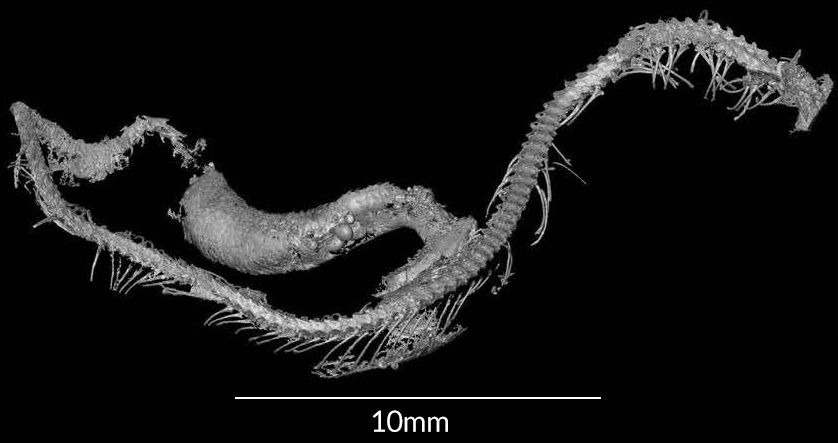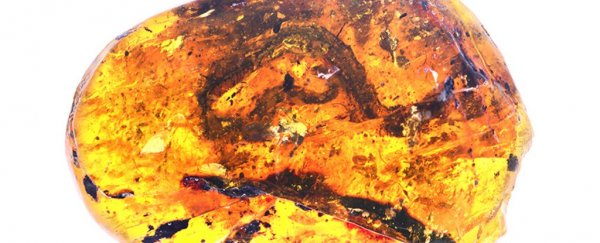This brand-new baby snake wouldn't have been on this world long when it died in the Cretaceous period.
But in an interesting twist of fate, it was encased in resin and found by humans 99 million years later in Myanmar.
The snake fossil is tiny – missing a head and with about 97 bones all up, the minuscule specimen comes out at only 47.5 millimetres (1.9 inches) in length.
"Even though it is a baby, there are very unique features of the top of the vertebrae that have never been seen before in other fossil snakes of a similar kind," palaeontologist Michael Caldwell from the University of Alberta explained to LiveScience.
"Xiaophis fits into the base of the snake family tree, and into a group of snakes that appear to be very ancient."
The researchers have named the new species Xiaophis myanmarensis, and believe that it's related to some modern snakes in South East Asia.
"It is clear that this little snake was living in a forested environment with numerous insects and plants, as these are preserved in the clast," Caldwell said to University of Alberta online magazine Folio.
"Not only do we have the first baby snake, we also have the first definitive evidence of a fossil snake living in a forest."
Caldwell explains that this is one of the first baby snake fossils found whatsoever, so the fact that it is also 99 million years old is just the cherry on top.
"Even if something that small was preserved in the fossil record, in normal fossil preservation styles, you'd never find it," Caldwell explains to Science News.
Because of the way normal fossils are created, the little snakes would be crushed and separated in the sedimentary rock. According to the researchers, it was luck this one was actually caught in amber.
But what's cool about this little amber snake isn't just what we know about it. It also brings up a series of interesting questions.
 An X-ray of the baby snake. (L Xing et al./Science Advances 2018)
An X-ray of the baby snake. (L Xing et al./Science Advances 2018)
"Whether or not these early snakes were giving live birth, which is common in modern snakes, or whether they were hatching from eggs, is unclear," said Caldwell to National Geographic.
"I can't say if it was still in the egg, and it broke and the little guy was caught up in a blob of amber, or if it had just hatched."
Myanmar is a pretty good place to find ancient critters stuck in amber. Back in June, different researchers found a tiny frog from the same time period, making it the oldest direct evidence of frogs in a tropical rainforest.
We've also found birds, a chameleon, a "vampire" ant, and even a small feathered dinosaur tail in amber from Myanmar.
The chunk of amber that holds the baby snake also has a scrap of shed skin that the researchers believe might have once belonged to a larger snake.
However, they can't tell if the snake is the same species as the baby, or if it's something different all together.
Either way, considering all these amazing finds, we're sure this won't be the last time we're hearing about incredible discoveries encased in amber from Myanmar.
The research has been published in Science Advances.
